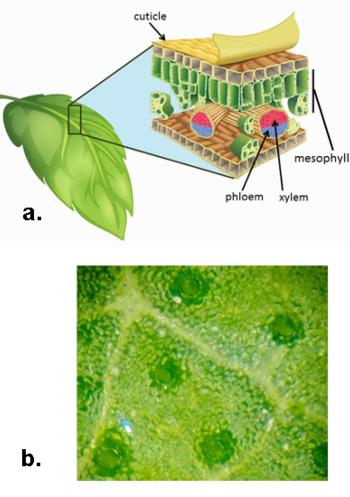Photosynthesis & Respiration
Overview | What is a Tree? | Photosynthesis & Respiration | Sources & Sinks | Fruit Quality | Tree Structure & Light Capture | Bearing Habit | Alternate Bearing | Reviewers & Credits
Photosynthesis
Light interception by leaves powers photosynthesis
All organisms, animals and plants, must obtain energy to maintain basic biological functions for survival and reproduction. Plants convert energy from sunlight into sugar in a process called photosynthesis. Photosynthesis uses energy from light to convert water and carbon dioxide molecules into glucose (sugar molecule) and oxygen (Figure 2). The oxygen is released, or “exhaled”, from leaves while the energy contained within glucose molecules is used throughout the plant for growth, flower formation, and fruit development.


The ends of both the xylem and phloem transport systems can be seen within each leaf vein (Figure 3). The structure of xylem and phloem in a plant is analogous to arteries and veins in humans, which move blood to and from the heart and lungs.
For more information regarding the structure and function of xylem and phloem, review the Irrigation and Rootstock sections.
Leaves contain water which is necessary to convert light energy into glucose through photosynthesis. Leaves have two structures that minimize water loss, the cuticle and stomata. The cuticle is a waxy coating on the top and bottom of leaves which prevents water from evaporating into the atmosphere (Figure 3a).
Although the cuticle provides important protection from excessive water loss, leaves cannot be impervious because they must also allow carbon dioxide in (to be used in photosynthesis), and oxygen out. These gases move into and out of the leaf through openings on the underside called stomata (Figure 3b). After carbon dioxide enters the leaf through stomata it moves into the mesophyll cells where photosynthesis occurs and glucose is constructed.
Respiration
Photosynthesis is the process by which plants use light energy to convert carbon dioxide and water into sugars. The sugars produced by photosynthesis can be stored, transported throughout the tree, and converted into energy which is used to power all cellular processes. Respiration occurs when glucose (sugar produced during photosynthesis) combines with oxygen to produce useable cellular energy. This energy is used to fuel growth and all of the normal cellular functions. Carbon dioxide and water are formed as by-products of respiration (Figure 4).

Respiration occurs in all living cells, including leaves and roots. Since respiration does not require light energy, it can be conducted at night or during the day. However, respiration does require oxygen which can be problematic for roots which are overwatered or in soils with poor drainage. If roots are inundated for long periods of time they cannot take up oxygen and convert glucose to maintain cell metabolic processes. As a result, waterlogging and excessive irrigation can deprive roots of oxygen, kill root tissue, damage trees, and reduce yield.
